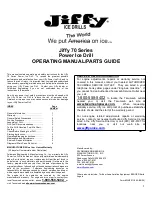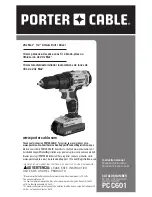
-19-
DRIVING SCREWS (FIG. 19)
Try to use standard-type screws for easy driving
and improved grip.
a. Install the correct driver bit.
b. Ensure that the torque-adjustment ring is set
to the most suitable setting. If in doubt, start
with a low setting and gradually increase
the setting as necessary. Do not change the
torque setting when the tool is running.
c. Use the correct gear (“1” or “2”) for the job and
initially apply minimal pressure to the variable
speed trigger switch. Increase the speed only
when full control can be maintained.
d. It is advisable to drill a pilot hole first. This
hole should be slightly longer than the screw
to be driven and just smaller than the shank
diameter of the screw. The pilot hole will act
as a guide for the screw and will also make
tightening the screw less difficult. When
screws are positioned close to an edge of the
material, a pilot hole will also help to prevent
splitting of the wood.
e. Use a countersinking bit (sold separately) to
accommodate the screw head so that it does
not protrude from the surface.
f. Keep sufficient pressure on the drill to prevent
the bit turning out of the screw head. The
screw head can easily become damaged,
making it difficult to drive home or remove.
g. To stop the drill/driver, release the trigger
switch and allow the tool to come to a
complete stop.
MASONRY DRILLING (MODEL FX1271T
ONLY)
For maximum performance, use carbide-tipped
masonry bits when drilling holes in brick, tile,
concrete, etc.
•
Maintain the speed and pressure that allow
drilling without overheating the bit or drill.
Applying too much pressure will:
–
Overheat the drill.
–
Wear the bearings.
–
Bend or burn bits.
–
Produce off-center or irregular-shaped holes.
•
Apply light pressure and medium speed for
best results in brick.
•
Apply additional pressure for hard materials
such as concrete.
•
When drilling holes in tile, practice on a
scrap piece to determine the best speed and
pressure. To prevent the drill bit from skidding/
sliding, first apply two pieces of masking tape
to create an “X” shape over the intended
drilling spot (Fig. 20).
•
Begin drilling at a very low speed to prevent
the bit from slipping off the starting point.
Fig. 19
Fig. 20
















































